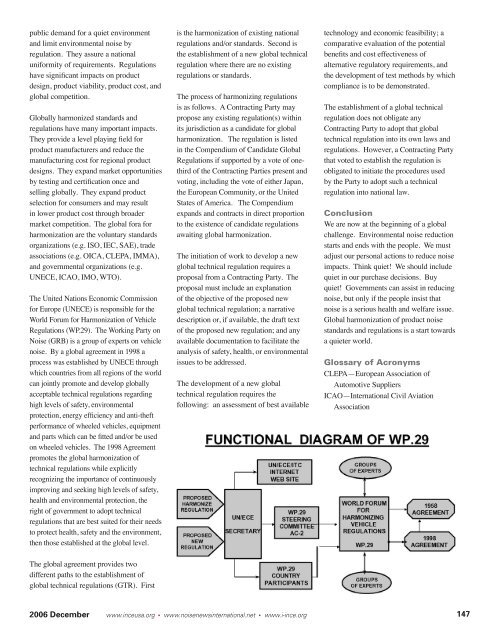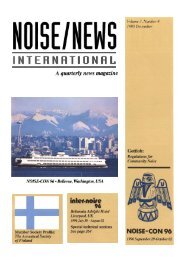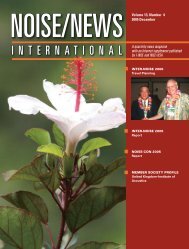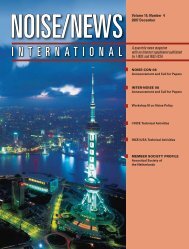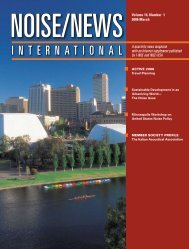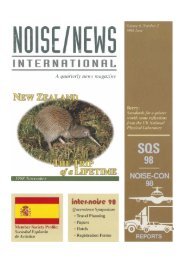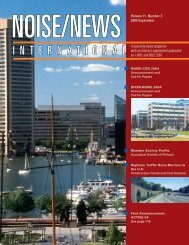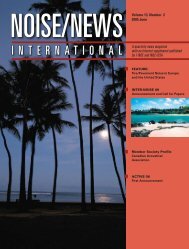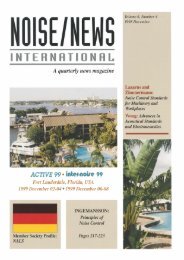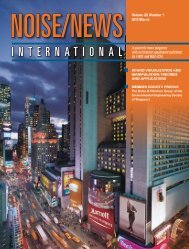Volume 14, Number 4, December, 2006 - Noise News International
Volume 14, Number 4, December, 2006 - Noise News International
Volume 14, Number 4, December, 2006 - Noise News International
Create successful ePaper yourself
Turn your PDF publications into a flip-book with our unique Google optimized e-Paper software.
public demand for a quiet environment<br />
and limit environmental noise by<br />
regulation. They assure a national<br />
uniformity of requirements. Regulations<br />
have significant impacts on product<br />
design, product viability, product cost, and<br />
global competition.<br />
Globally harmonized standards and<br />
regulations have many important impacts.<br />
They provide a level playing field for<br />
product manufacturers and reduce the<br />
manufacturing cost for regional product<br />
designs. They expand market opportunities<br />
by testing and certification once and<br />
selling globally. They expand product<br />
selection for consumers and may result<br />
in lower product cost through broader<br />
market competition. The global fora for<br />
harmonization are the voluntary standards<br />
organizations (e.g. ISO, IEC, SAE), trade<br />
associations (e.g. OICA, CLEPA, IMMA),<br />
and governmental organizations (e.g.<br />
UNECE, ICAO, IMO, WTO).<br />
The United Nations Economic Commission<br />
for Europe (UNECE) is responsible for the<br />
World Forum for Harmonization of Vehicle<br />
Regulations (WP.29). The Working Party on<br />
<strong>Noise</strong> (GRB) is a group of experts on vehicle<br />
noise. By a global agreement in 1998 a<br />
process was established by UNECE through<br />
which countries from all regions of the world<br />
can jointly promote and develop globally<br />
acceptable technical regulations regarding<br />
high levels of safety, environmental<br />
protection, energy efficiency and anti-theft<br />
performance of wheeled vehicles, equipment<br />
and parts which can be fitted and/or be used<br />
on wheeled vehicles. The 1998 Agreement<br />
promotes the global harmonization of<br />
technical regulations while explicitly<br />
recognizing the importance of continuously<br />
improving and seeking high levels of safety,<br />
health and environmental protection, the<br />
right of government to adopt technical<br />
regulations that are best suited for their needs<br />
to protect health, safety and the environment,<br />
then those established at the global level.<br />
is the harmonization of existing national<br />
regulations and/or standards. Second is<br />
the establishment of a new global technical<br />
regulation where there are no existing<br />
regulations or standards.<br />
The process of harmonizing regulations<br />
is as follows. A Contracting Party may<br />
propose any existing regulation(s) within<br />
its jurisdiction as a candidate for global<br />
harmonization. The regulation is listed<br />
in the Compendium of Candidate Global<br />
Regulations if supported by a vote of onethird<br />
of the Contracting Parties present and<br />
voting, including the vote of either Japan,<br />
the European Community, or the United<br />
States of America. The Compendium<br />
expands and contracts in direct proportion<br />
to the existence of candidate regulations<br />
awaiting global harmonization.<br />
The initiation of work to develop a new<br />
global technical regulation requires a<br />
proposal from a Contracting Party. The<br />
proposal must include an explanation<br />
of the objective of the proposed new<br />
global technical regulation; a narrative<br />
description or, if available, the draft text<br />
of the proposed new regulation; and any<br />
available documentation to facilitate the<br />
analysis of safety, health, or environmental<br />
issues to be addressed.<br />
The development of a new global<br />
technical regulation requires the<br />
following: an assessment of best available<br />
technology and economic feasibility; a<br />
comparative evaluation of the potential<br />
benefits and cost effectiveness of<br />
alternative regulatory requirements, and<br />
the development of test methods by which<br />
compliance is to be demonstrated.<br />
The establishment of a global technical<br />
regulation does not obligate any<br />
Contracting Party to adopt that global<br />
technical regulation into its own laws and<br />
regulations. However, a Contracting Party<br />
that voted to establish the regulation is<br />
obligated to initiate the procedures used<br />
by the Party to adopt such a technical<br />
regulation into national law.<br />
Conclusion<br />
We are now at the beginning of a global<br />
challenge. Environmental noise reduction<br />
starts and ends with the people. We must<br />
adjust our personal actions to reduce noise<br />
impacts. Think quiet! We should include<br />
quiet in our purchase decisions. Buy<br />
quiet! Governments can assist in reducing<br />
noise, but only if the people insist that<br />
noise is a serious health and welfare issue.<br />
Global harmonization of product noise<br />
standards and regulations is a start towards<br />
a quieter world.<br />
Glossary of Acronyms<br />
CLEPA—European Association of<br />
Automotive Suppliers<br />
ICAO—<strong>International</strong> Civil Aviation<br />
Association<br />
The global agreement provides two<br />
different paths to the establishment of<br />
global technical regulations (GTR). First<br />
<strong>2006</strong> <strong>December</strong> www.inceusa.org • www.noisenewsinternational.net • www.i-ince.org<br />
<strong>14</strong>7


